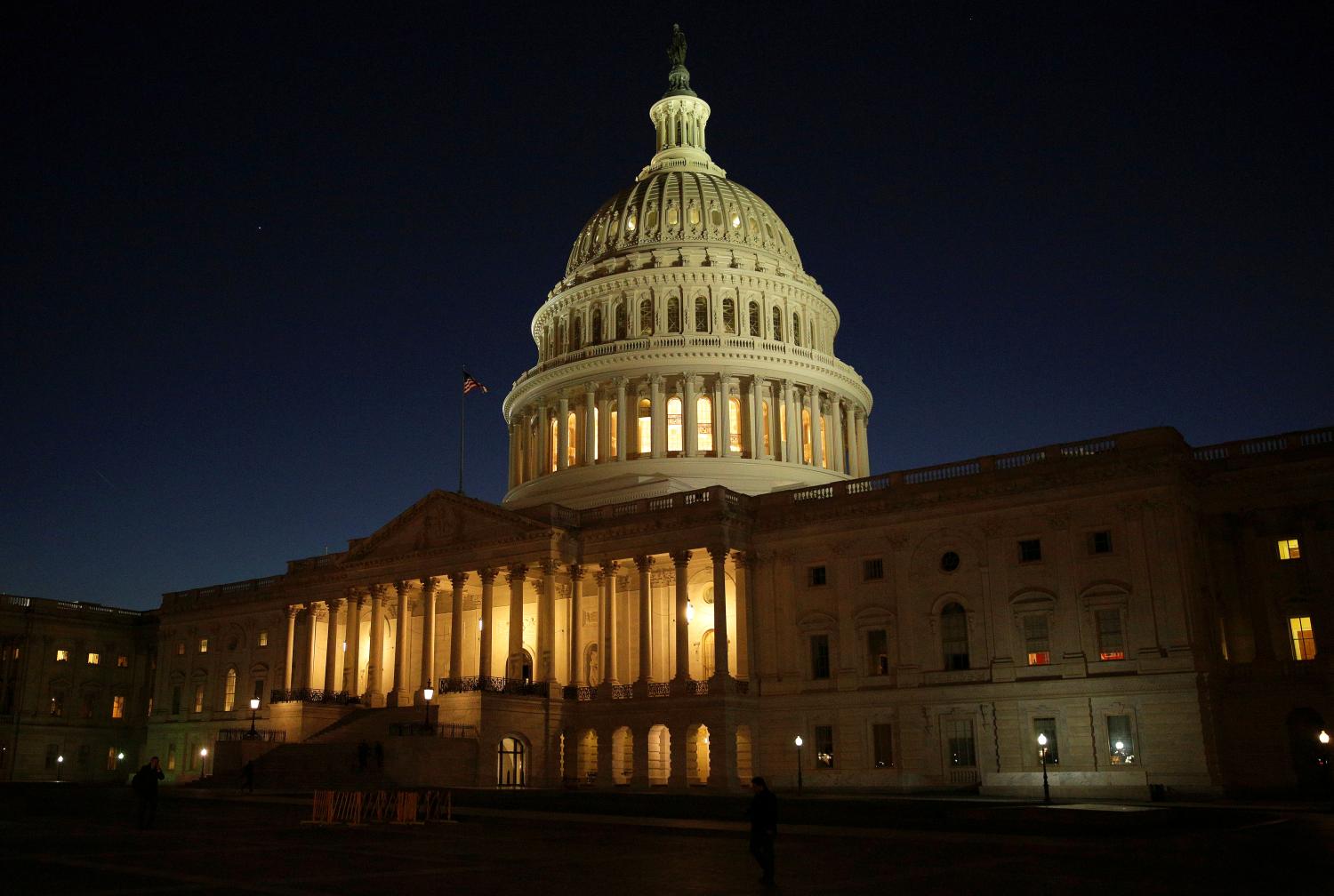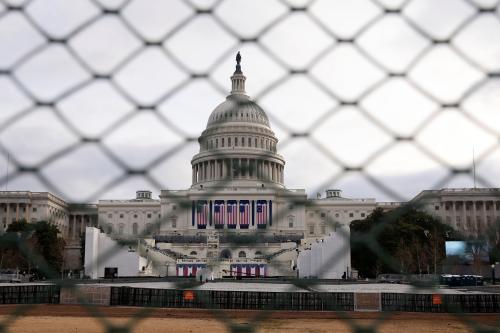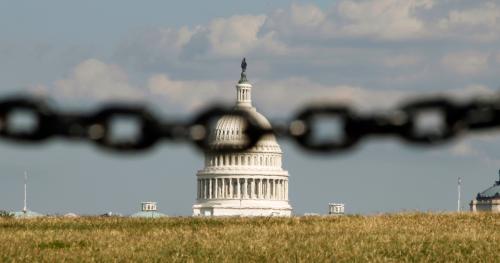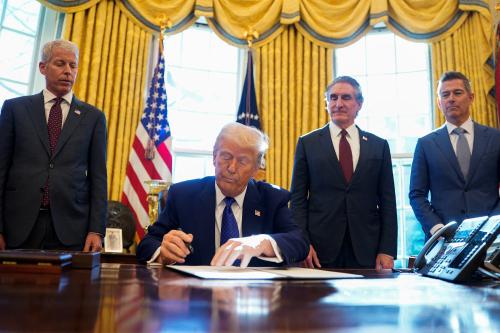This report is part of the Series on Regulatory Process and Perspective and was produced by the Brookings Center on Regulation and Markets.
The Trump administration recently released its regulatory blueprint for the next several months. Unsurprisingly, the plan centers on the administration’s deregulatory agenda. Benefit-cost analysis (BCA) will inevitably play an important role in this process.1 This is because, as required under Executive Order 12,866, agencies will have to show quantitatively that the benefits of repeal justify the costs.
Many of the rules the Trump administration will be targeting were put into place—and justified through BCA—just a few years ago during the Obama administration. To repeal them, the very same agencies (and often even the same personnel) that put the rules in place will have to use the same analytical techniques to demonstrate that these rules are no longer warranted
One might reasonably think that having gone through this analytical process the first time would have created a safeguard against removing these rules. This post explains why that’s not the case.
Quantitatively Justifying Deregulation
Because it is only required for a subset of the most important rules,2 BCA does not constrain all regulations. For those rules that do require analysis, agencies looking to pare back existing regulations will need to conduct BCA de novo. There are at least three avenues by which an agency’s new BCA could come to the conclusion that deregulation is justified.
First, agencies can choose to rely on different data sources to show that an existing rule is no longer quantitatively justified. For regulations that have been in effect for a while, agencies may, for instance, be able to use new data to show that expected benefits never materialized.
The BCA process can, and likely will, be manipulated to facilitate Trump’s deregulatory agenda, just as it has been adapted to suit the agenda of every president in recent memory.
Second, agencies may choose less costly or less intrusive regulatory approaches. For example, an agency might propose to substitute an information disclosure provision for a regulatory mandate, which still accomplishes the same policy goal. Reducing the cost term in that way makes it relatively straightforward for agencies to demonstrate the value of a new approach.
Third, BCA is built upon a series of assumptions about how the world works, and agencies may rely on new and different assumptions that yield different conclusions. Some assumptions are specific to particular rules, and agencies revisiting old rules may choose to rely on new assumptions that were not used in previous BCAs. The Trump administration might also choose to alter across-the-board assumptions that apply to all of an agency’s rules or to all agencies in the executive branch.
Where Politics Comes into Play
Each of these approaches (or some combination of the three) can be used to justify deregulation through BCA. In some cases, the deregulatory changes that occur will streamline existing regulatory burdens. Such rollbacks might happen under any administration, regardless of ideology. For instance, the Obama administration—which pursued a very different regulatory vision from Trump’s—pushed agencies to look back at their regulations and remove any that were outdated or ineffective. Trump, however, envisions deregulatory changes on a broader scale. And just as past administrations have done, the new administration can stack the analytical deck in ways that favor a particular outcome—in this case, deregulation.
The Trump administration has already made one broad analytical change that effectively lowers the bar for agencies to roll back climate-related regulations by changing how agencies calculate the benefits of CO2 emission reductions. The Obama administration established administration-wide estimates of the “social cost of carbon,” which agencies were to include in their analyses. These estimates were determined via an interagency review process, which was influenced by two key considerations. First, the estimates included the global benefits (i.e., the benefits to the rest of the world) of emissions reductions achieved within the U.S. Second, they relied on a lower discount rate—the rate at which agencies calculate the present value of future actions—than used for other environmental emissions. The Trump administration’s withdrawal of the carbon calculation allows agencies to revert to assessing just the domestic benefits of their climate regulations, using the same discount rates typically used for other (non-climate) regulations. The net effect is that climate regulations, which have near-term costs and long-term benefits, will yield lower estimated net benefits.
Other assumptions could potentially be changed to favor deregulation. For instance, agencies rely on estimates of the Value of a Statistical Life (VSL) to calculate the benefits of regulations that result in reduced mortality. Each agency has its own VSL calculation, which they can adjust to reflect societal changes. Trump’s agencies could conceivably adjust VSLs downward, making regulations appear less beneficial than they might otherwise. Such changes have been politically controversial before: the Environmental Protection Agency was accused of biasing the VSL downward during the Bush years and biasing it upward during the Obama years.
Finally, agencies may face pressure from the administration to deemphasize regulatory benefits when conducting BCA. As critics have noted (see here and here), Trump’s “2-for-1” executive order, which requires agencies to repeal two regulations for every new one they enact, references regulatory costs 18 times but omits any mention of regulatory benefits.
In general, costs are easier to quantify than benefits, since it can be difficult to put monetary values on things like human dignity and equity. While it is not unreasonable for agencies to discuss such benefits qualitatively—and is even envisioned in BCA guidelines—doing so may open the door to manipulation or misuse. If one side of the ledger (costs) is tangible and the other (benefits) is not, determining whether the former exceeds the latter is inevitably a judgment call. Consider, for example, a rule that is projected to cost $250 million each year for the next 10 years. On the benefits side of the ledger, the agency only partially quantifies the rule’s benefits at, say, $100 million annually and then indicates that the rule will enhance privacy for the affected population, but provides no monetary value of that benefit. Overseen by an office that is headed by a deregulation-focused Trump appointee and under considerable political pressure to deregulate, an agency can easily make the case that the benefits of privacy do not justify the costs of the rule.
Regulatory Analysis is Still Valuable
BCA is not immune to political influence, but the baby should not be thrown out with the bath water. Just because BCA can be manipulated doesn’t mean it isn’t valuable. Regulation invariably creates societal winners and losers; conducting regulatory analysis forces an agency to be more transparent regarding its assumptions. In other words, the practice provides a departure point for an informed discussion among experts and stakeholders.
Nonetheless, to the extent that agencies do inappropriately manipulate BCA in their pursuit of regulatory or deregulatory goals, there is an additional backstop. Courts have recently turned a more critical eye towards agency regulatory analyses that are insufficiently rigorous.3 Given this trend and the Obama-appointee-heavy makeup of the DC Circuit, agencies are not guaranteed a free pass on their analyses. Using the courts as a way to check the quality of BCA is imperfect, since it requires vigilance and resources, but it may well be the stage upon which future battles over deregulation will be fought.
The author did not receive financial support from any firm or person for this article or from any firm or person with a financial or political interest in this article. She is currently not an officer, director, or board member of any organization with an interest in this article.
-
Footnotes
- There are a number of other ways that agencies assess regulatory actions in addition to BCA, including break-even analysis, cost effectiveness analysis, and feasibility analysis. I focus on BCA in this post since it is the most widely known analytical tool.
- Generally speaking, under Executive Order 12,866 only those regulations that are expected to impose at least $100 million in annual costs are subject to the BCA requirement. Additionally, independent agencies—those outside of the executive branch—are exempt.
- This is an evolving area of jurisprudence, but see Michigan v. EPA 576 U.S. ___ (2015) and Business Roundtable v. SEC, 647 F.3d 1144 (DC Cir. 2011).
The Brookings Institution is committed to quality, independence, and impact.
We are supported by a diverse array of funders. In line with our values and policies, each Brookings publication represents the sole views of its author(s).







